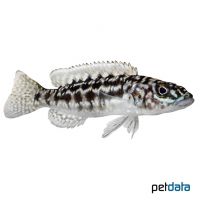Kendall's Lamprologus (Lepidiolamprologus kendalli)
| Kendall's Lamprologus Lepidiolamprologus kendalli | |
|---|---|
| Name | Kendall's Lamprologus |
| Name Lat. | Lepidiolamprologus kendalli |
| Synonym | Lamprologus nkambae |
| Family | Cichlids |
| Family lat. | Cichlidae |
| Order | Cichlids |
| Order lat. | Cichliformes |
| Origin | Lake Tanganyika |
| Habitat | Rocky intermediate zone |
| Diet | Carnivore |
| pH | 7.5-9.0 |
| Behavior | Predatory, aggressive |
| Keeping | Pair, harem |
| Care Level | Moderate |
| Reproduction | Substrate spawner |
| Breeding | Difficult |
| Life Span | 6-8 years |
| Protection | No |
| Metric Units | |
| Size | 13-16 cm |
| Temperature | 24-28 °C |
| Hardness | 15-18 °dH |
| Aquarium | ~ 350 l |
| US Units | |
| Size | 5"-6" |
| Temperature | 75-82 °F |
| Hardness | 267-320 ppm |
| Aquarium | ~ 90 gal |
Distribution and habitat
Kendall's cichlids occur exclusively (endemically) between Nkamba Bay in Zambia and Kala in Tanzania, in the south of Lake Tanganyika. There they live on the coast in the rocky littoral and the transition zones up to a depth of 40 meters.
Maintenance
The aquarium setup should have rocky structures that reach to the water surface, with plenty of caves, crevices and shelters to provide hiding places, as well as some open sandy areas.
No ammonia, ammonium or nitrite should be detectable, and the nitrate value should not exceed 100 mg/l. To ensure the water quality and oxygen content, a filter and heater adapted to the aquarium size is required, as well as lighting for the species-appropriate day-night rhythm of the animals.
Diet
In the wild they feed mainly on small fish, small crustaceans and insect larvae. The food supply consists of live, frozen and dry food. For a balanced diet, feed once a day with a high-quality dry food for Tanganyika cichlids (flakes, granules, pellets) as well as daphnia, artemia, mysis, mosquito larvae, etc. (live or frozen)
It is recommended to feed small portions several times a day. Only feed as much as will be eaten within a few minutes. A regular and varied diet promotes health and prevents deficiency symptoms.
Behaviour and compatibility
They are predatory and territorial fish that occupy territories which they defend vigorously against conspecifics. During the breeding season they are also aggressive towards other fish. They should be kept in pairs. Keeping multiple pairs is only recommended in a much larger and richly structured tank. They can be socialized with other large cichlids from Lake Tanganyika that do not fit their prey pattern
Basically, only compatible fish species with similar demands on water condition and water temperature may be socialized.
Sex dimorphism
The sexes are difficult to distinguish. Adult males are much larger than the females.
Reproduction and breeding
They are mating substrate spawners (hiding spawners) that lay the spawn, several 100 eggs, in caves or rock crevices. The female performs the brood care, while the male defends the territory. The young fish hatch after 2-4 days and swim free after about 7 days. They are cared for by the parents for a short time before brood care ends.
Fry must be fed several times a day with special rearing food (Artemia nauplii). In community tanks breeding is hardly possible, because the fry are easy prey.
Important
There are several differently colored stando varieties in their range.
The well-being of the fish should be checked regularly. Temperature should be checked daily, pH, hardness and nitrate levels at least fortnightly. Regular partial water changes are recommended, even if the contaminant level has not yet reached the upper limit. Sudden changes in water quality should be avoided. Newly introduced fish must be accustomed slowly to the water in the aquarium.
Further literature can be found in your pet store.
References
Text: Werner Winter; Image: petdata
Source: BMELV (1998): Tierschutzgutachten - Haltung von Zierfischen (Süßwasser); BAENSCH & RIEHL (2004): Aquarien Atlas Bd. 4, Mergus Verlag; ENGELMANN (2005): Zootierhaltung - Tiere in menschlicher Obhut: Fische, Verlag Harri Deutsch
- Gemäß § 21 Abs. 5 Tierschutzgesetz idgF
